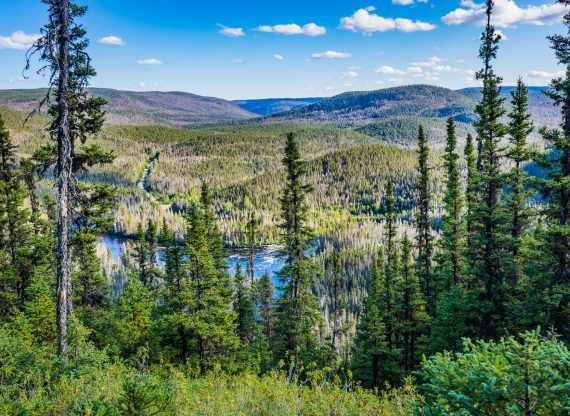Why Economic Growth Is Good for the Environment

Viewpoint examining how in the long run, growth can be a powerful tool for improving the environment, especially in economically free societies
This Viewpoint published by the MEI explains that growth in the average income of a society’s inhabitants tends to be correlated with growth in forest cover. “A more prosperous society tends to be a greener society,” asserts Vincent Geloso, senior economist at the MEI and author of the study.
 Related Content
Related Content
 |
 |
 |
| La croissance économique a le pouce vert(Le Devoir, July 17, 2023) | Interview (in French) with Vincent Geloso (Alexandre Dubé, QUB Radio, July 13, 2023) |
This Viewpoint was prepared by Vincent Geloso, Assistant Professor of Economics at George Mason University and Senior Economist at the MEI. The MEI’s Environment Series aims to explore the economic aspects of policies designed to protect the natural world in order to encourage the most cost-effective responses to our environmental challenges.
It is popular in certain circles to attack the very idea of economic growth. This series(1) of brief studies examines some common misconceptions behind these attacks.
One criticism sometimes made is that economic growth hurts the environment. Yet in many ways, economic growth can be a powerful tool for improving the environment, especially in economically free societies.
A common caricature of the effects of economic growth on the environment is one of endless consumption and waste generation on a finite planet. There are, however, two major problems with this pessimistic view.
First, it assumes that most people do not place any value on a clean environment and will never adjust their behaviour to guarantee they live in such an environment. This is contradicted both by observation and by economic data. And because they in fact do care, there is a point at which income will be high enough that people will start considering that a clean environment is something worth paying for.(2) At that point, they will demand goods and services that actually protect the environment.
Second, it assumes that economic growth is generated by doing more while using ever more resources. That is incorrect. Economic growth is about improving productivity, and that means liberating resources for better uses. For example, productivity growth in agriculture since 1960 has allowed three times more people to be fed, with a larger number of calories, using more or less the same quantity of land.(3) In fact, since 1998, the Food and Agriculture Organization notes that total agricultural land use has fallen, even as the food supply has increased.(4) This means productivity growth has been so rapid that it has liberated land from being used. In rich countries that enjoyed the fastest growth during the 20th century, this trend has been even more pronounced.(5)
The Environmental Kuznets Curve
The result of these two factors is the inverted “U” of what is known as the Environmental Kuznets Curve, named after Nobel laureate Simon Kuznets.(6) The idea is that environmental quality may fall as income rises, but only up to a point. Beyond that point, more economic growth improves environmental quality. Such a relationship has been observed for fisheries, waste production, biodiversity, and multiple forms of air pollution.(7) There are even strong signs of this, under certain conditions, for greenhouse gases.(8)
The clearest example is forest cover over the course of the 20th century. As Western countries industrialized and populations grew, forest cover shrank.(9) However, productivity gains in agriculture eventually led to fewer acres needing to be used. Innovations in transportation meant that production could be concentrated in areas where growing conditions were best, even if they were further from points of consumption.(10) Automobiles and tractors allowed millions of acres formerly dedicated to raising horses and mules to be returned to nature.(11) Simultaneously, undisturbed nature, wildlife, and activities in the outdoors gradually became more highly valued. In sum, once a certain critical point in economic development was reached, forests made a comeback.
This still holds true today. As can be seen in Figure 1, richer countries tend to experience gains in forest cover, whereas poorer countries tend to deforest. Thus, a 10% increase in income increases the net forest cover by 0.02 percentage points. This may seem small, but it is equal to a fifth of the average change for all 103 countries in the graph.

Institutional Conditions
The Environmental Kuznets Curve has its limitations, as many scholars point out.(12) Generally, critics argue that the curve fails to materialize for certain categories of environmental indicators such as greenhouse gas emissions, or that certain conditions must be present for the curve to exist. However, one understudied category of criticism is that of economists who emphasize that the benefits of economic growth are conditional on the presence of economic freedom (limited government regulation, small government, strong property rights, open trade, and sound money).(13)
There are three reasons to emphasize the importance of economic freedom to the Environmental Kuznets Curve effect. First, economic freedom fuels economic growth and development.(14) This means an economy takes less time to arrive at the critical turning point where the environment starts improving as incomes increase. Second, thanks to strong property rights (one component of economic freedom), innovators can more easily secure the fruits of technological innovation.(15) This stimulates innovation that could be environmentally beneficial, while fewer regulatory barriers may facilitate the adoption of new technologies by other firms. Third, strong property rights make it easy to assign liability. Parties affected by poor environmental situations can thus more easily use the courts to seek remedies, and given such legal possibilities, firms have an incentive to cut back on polluting activities from the start.
Economically freer countries therefore tend to reach the critical point faster, with less environmental damage. Studies that have tried to account for the importance of economic freedom tend to find strong signs of the Environmental Kuznets Curve in economically free and rich nations.(16)
The reality is that economic growth can be good for the environment in the long run. However, this is conditional on governmental policies that protect property rights, encourage innovation, and foster entrepreneurship.
References
- For the first two in the series, see Vincent Geloso, “Why Economic Growth Is Good for Your Health,” MEI, Viewpoint, April 2023; Vincent Geloso, “Why Economic Growth Is Good for the Poor,” MEI, Viewpoint, June 2023.
- Julian Lincoln Simon, The Ultimate Resource 2, “Chapter 15: The Peculiar Theory of Pollution,” Princeton University Press, 1996.
- Jesse H. Ausubel, Iddo K. Wernick, and Paul E. Waggoner, “Peak Farmland and the Prospect for Land Sparing,” Population and Development Review, Vol. 38, 2012, pp. 227-228 and 231-233.
- Pierre Desrochers, Vincent Geloso, and Joanna Szurmak, “Care to Wager Again? An Appraisal of Paul Ehrlich’s Counterbet Offer to Julian Simon,” Parts 1 and 2, Social Science Quarterly, Vol. 102, No. 2, 2021, pp. 793-794 and 809.
- Jesse H. Ausubel, Iddo K. Wernick, and Paul E. Waggoner, op. cit., endnote 3, pp. 224-227.
- Susmita Dasgupta et al., “Confronting the environmental Kuznets curve,” Journal of Economic Perspectives, Vol. 16, No. 1, 2002, p. 147.
- Muhammad Saqib and François Benhmad, “Updated meta-analysis of environmental Kuznets curve: Where do we stand?” Environmental Impact Assessment Review, Vol. 86, 2021, pp. 9-10.
- Christian Bjørnskov, “Economic freedom and the CO2 Kuznets Curve,” IFN Working Paper No. 1331, Research Institute of Industrial Economics (IFN), 2020, p. 18.
- Jesus Crespo Cuaresma et al., “Economic development and forest cover: evidence from satellite data,” Scientific Reports, Vol. 7, No. 1, 2017, p. 6; Nicole Caravaggio, “A global empirical re-assessment of the Environmental Kuznets curve for deforestation,” Forest Policy and Economics, Vol. 119, 2020, pp. 9-11.
- Jason M. Beddow and Philiip G. Pardey, “Moving matters: the effect of location on crop production,” Journal of Economic History, Vol. 75, No. 1, 2015, p. 229.
- Alan L. Olmstead and Paul W. Rhode, “Reshaping the landscape: the impact and diffusion of the tractor in American agriculture, 1910–1960,” Journal of Economic History, Vol. 61, No. 3, 2001, p. 692.
- Leigh Raymond, “Economic growth as environmental policy? Reconsidering the Environmental Kuznets Curve,” Journal of Public Policy, Vol. 24, No. 3, 2004, pp. 343-344; William T. Harbaugh, Arik Levinson, and David Molloy Wilson, “Re-examining the empirical evidence for an environmental Kuznets curve,” Review of Economics and Statistics, Vol. 84, No. 3, 2002, p. 549.
- Vincent Geloso, “Statogenic climate change? Julian Simon and institutions,” Review of Austrian Economics, Vol. 35, No. 3, 2022, pp. 345-355.
- Joshua C. Hall and Robert A. Lawson, “Economic freedom of the world: An accounting of the literature,” Contemporary Economic Policy, Vol. 32, No. 1, 2014, p. 8.
- Pierre Desrochers, “How did the invisible hand handle industrial waste? By-product development before the modern environmental era,” Enterprise & Society, Vol. 8, No. 2, 2007, pp 348-374.
- Ram Pandit and David N. Laband, “Economic freedom, corruption, and species imperilment: a cross-country analysis,” Society and Natural Resources, Vol. 22, No. 9, 2009, pp. 818-820; Christian Bjørnskov, “Do liberalising reforms harm the environment? Evidence from the post‐ communist transition,” Economic Affairs, Vol. 38, No. 1, 2018, pp. 29-34.

